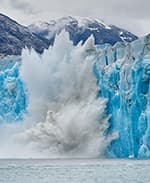- The polar regions as components of the global climate system
- > The Arctic and Antarctic are the cooling chambers of our planet. Having a very limited supply of solar radiation, they attract warm air and ocean currents from the tropics, cool them down and send them back towards the equator as floating ice. In this way, the polar regions regulate the distribution of heat on the Earth. This mechanism will only continue to function smoothly, however, if the interactions between sea ice, glaciers, ocean and atmosphere do not change.

A chain reaction with an icy end
It is so extremely cold in the polar regions because of a self-reinforcing process that involves several factors. Fundamentally, it is due to the fact that much less solar energy reaches the Earth’s surface in the polar regions than it does, for example, in Central Europe or at the equator. The reasons for this are the low angle of incoming sunlight, the tilt of the Earth’s axis and the orbit of our planet around the sun. This combination of factors results in the polar regions being generally undersupplied with energy compared to the rest of the world, and being completely cut off from the sun’s heat during the polar nights. While the polar regions receive sparse solar radiation, the tropics receive a great deal, which results in a marked temperature contrast between the two regions. The large air and ocean currents that we see today are generated as responses to compensate for this difference. They distribute heat from the tropics around the globe and thereby determine the weather conditions throughout the world. Without the cold regions in the far north and south, these global circulation patterns of air and water masses would not exist. It is also important to note that strong bands of wind form in both hemispheres that act as protective walls to prevent heat from the tropics from reaching deep into the polar regions. However, the freezing conditions in the Arctic and Antarctic also mean that precipitation in these regions is primarily in the form of snow, and that large areas of the polar surface waters freeze over in winter. Because the white snow and ice covers have a high reflective capability, called the albedo, a large proportion of the solar radiation is not absorbed, and thus cannot contribute to warming the surface of the Earth. In this way, the snow and ice surfaces amplify cooling in the polar regions. To scientists this kind of effect is known as positive feedback. The fact that cold air cannot hold large amounts of water vapour is another factor that facilitates the low temperatures. Especially over central Antarctica, the air masses lack this important heat reservoir, and thus also the capability to form a thick cloud cover. This could otherwise help to limit the cooling. Instead, the dry air amplifies the cooling effect and, in concert with the other factors, helps to create the ideal conditions for the formation of immense ice sheets, glaciers and areas of sea-ice. The various forms of polar ice and their strong albedo are fundamental components of the cooling and climate system of our Earth. They regulate chemical and biological cycles and interact very closely with the ocean, the atmosphere and the land. However, there are numerous geographical differences between the Arctic and Antarctic regions. In the Arctic Ocean, with its shallow shelf seas, the water masses circulate in a completely different way than they do in the Southern Ocean, a ring ocean that surrounds a large continent. These regional differences likewise affect the polar ice masses. In the Antarctic the conditions result, among other things, in large-scale melting of the Southern Ocean sea ice in summer. In the Arctic, on the other hand, slightly less than half of the sea ice survives the summer, and researchers there refer to a permanent sea-ice cover. The amounts of precipitation that fall in the Arctic and Antarctic are also different, resulting in different rates of growth on the ice sheets of Greenland and Antarctica. There is, however, one thing that the ice masses of the two regions have in common – they both react very sensitively to increasing temperatures.
![Why it is so cold in the polar regions © [M] mare, Foto © Jacob Aue Sobol/Magnum Photos/Agentur Focus Why it is so cold in the polar regions © [M] mare, Foto © Jacob Aue Sobol/Magnum Photos/Agentur Focus](https://worldoceanreview.com/wp-content/uploads/2019/10/wor6_kapitel_k_2a.jpg)
